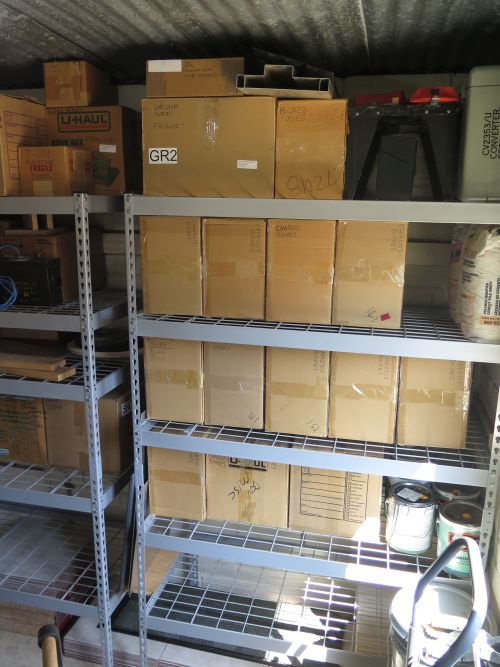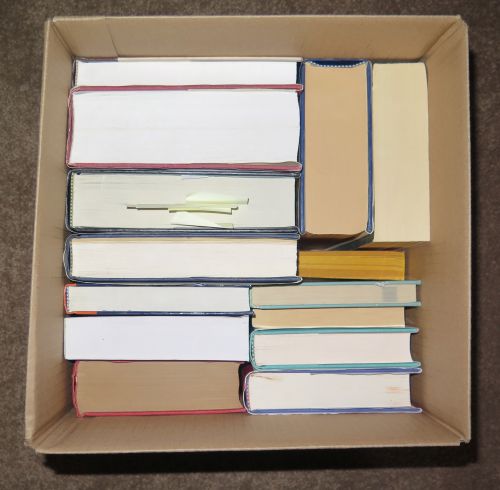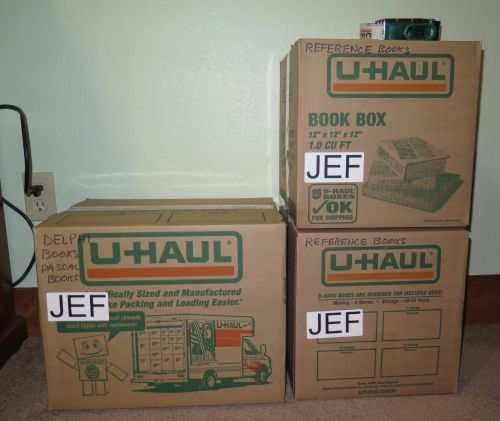
Over the years I’ve developed a couple of strong heuristics relating to Stuff:
- Know what you have.
- Know where it is.
- Store it in an orderly fashion, to facilitate heuristics 1 and 2.
One of the ways I developed these heuristics was by moving every three or four years as I chased jobs around the country. Time and again, everything we owned went into boxes, much of which then sat around in the basement of our new place, sometimes for years, before we opened up the boxes and looked at it. In the meantime, we often forgot what we had (or couldn’t find it) which led us to buy duplicate Stuff.
Our most recent move was better than many, because we had a lot more time to plan the packing. Our first few moves were corporate moves, which meant that my employers hired a moving company, which came to our house and loaded our Stuff into boxes in one furious day. That was worst-case, because there was no attempt at organized packing. Whatever was in the living room went into boxes. Whatever was in the bedroom went into boxes. Etc. Every box was a mishmash of books, knicknacks, throw pillows, coasters, and whatever other oddments were lying around the morning the movers came.
Later on, when we paid for our own moves, we packed our Stuff by ourselves. There were boxes of books, clearly labeled. (Lots of them.) There were boxes of kitchen gadgets, and nothing but kitchen gadgets. There were boxes of CDs and DVDs (ok, we mixed those) that did not contain books or kitchen gadgets. This made unloading it all into cabinets and bookshelves and pantries a whole lot easier.
My workshop was a whole separate problem. Ordinary life has relatively few packable categories: Clothes, shoes, kitchen stuff, books, wall art, dog supplies, knicknacks, garden supplies, etc. Out in my workshop, I had shelves full of Odd Lots in a hundred different categories, and in few cases enough of any one category to fill a box. Variable capacitors, panel meters, milk jugs full of tube sockets, tubes, transistors, test gear, and cubic yards of indescribable (except by techie nerds of my generation) kipple. So mixing categories in boxes was unavoidable, with the commonest single box label reading ODD JUNK.
Downsizing from 4500 square feet with a huge workshop to 3000 square feet with one small single-car garage as a workshop complicated matters further. I got rid of a lot of stuff in Colorado, including all but the very best of my vintage radios. I planned my shop in detail to waste as little space as possible, drew it all out on Visio, and emptied as many of the boxes onto shelves and bins and new Elfa as I could.
The rest went into the tack shed. Life got busy, and all those boxes of ODD JUNK remained unmolested until their weight began to collapse the shed’s cheap plywood built-in shelves. Just last week, I piled it all onto the patio, bought heavy-duty steel shelves at Home Depot, tore out the crappy plywood shelves, assembled the new steel shelves, and then began piling the goods back onto the shelves in the shed. Roy Harvey wanted to see a picture of the pile, which I took but didn’t consider notable enough to post. See below:

There was a similar pile (though of much lighter boxes) atop our big patio table. I didn’t take a picture of that. By now, egad, I know what piles of boxes look like.
Once the new shelves in the shed were ready, I spent days opening up boxes of ODD JUNK, making piles by category, and either throwing out or re-boxing the piles. In the process, I remembered a lot of Stuff that I had long forgotten, some of it packed up when we began preparations to move to Colorado in the fall of 2002. I found many things I’d been looking for, especially tools and telescope parts. I’m still tessellating in the shop, but overall, it was a useful endeavor.
Better still, the shed (which used to be packed to the rafters) is now only about half-full. It helped that we’re taking about half of the paint cans (full of paint going back to 2006) down to the hazardous waste drop-off. It also helps that the shelves I bought had more, well, shelves. I spaced the shelves to accomodate the most common moving boxes, including the many Waldenbooks book boxes I got for free when we moved to Colorado in 2003. (See the photo at the top of this entry.) So I’m getting a lot more bang per cubic foot out there.
Best of all, I reviewed what was in the boxes, and scribbled lists on the sides of the boxes with magic marker. I may have to hunt a little for the boxes in the future, but once I find the boxes, I’ll know instantly and in detail what’s inside them.
Retired people often downsize, and many of them in my circles have told that they don’t miss all the Stuff they got rid of when they did. Me, I can handle a little of that. I got rid of my snowmobile suit, after all. But if you can’t lay hands on a 6AG7 when you need one, what is life?


 Carol’s packing glassware and kitchen and office stuff and much miscellany. I have to get rid of a solar panel that I cobbled up in 1977 from six 6-cell subpanels that doesn’t work anymore, and I would like to investigate the peculiar failure mode if I had time: When first placed in the Sun it generates 17 volts, but over a period of no more than five minutes the voltage drops down under 10 volts and eventually to 5. It hasn’t been in the Sun at all these past 40 years…so what died? I’m curious, but not curious enough to keep it and do exploratory surgery on it.
Carol’s packing glassware and kitchen and office stuff and much miscellany. I have to get rid of a solar panel that I cobbled up in 1977 from six 6-cell subpanels that doesn’t work anymore, and I would like to investigate the peculiar failure mode if I had time: When first placed in the Sun it generates 17 volts, but over a period of no more than five minutes the voltage drops down under 10 volts and eventually to 5. It hasn’t been in the Sun at all these past 40 years…so what died? I’m curious, but not curious enough to keep it and do exploratory surgery on it.











